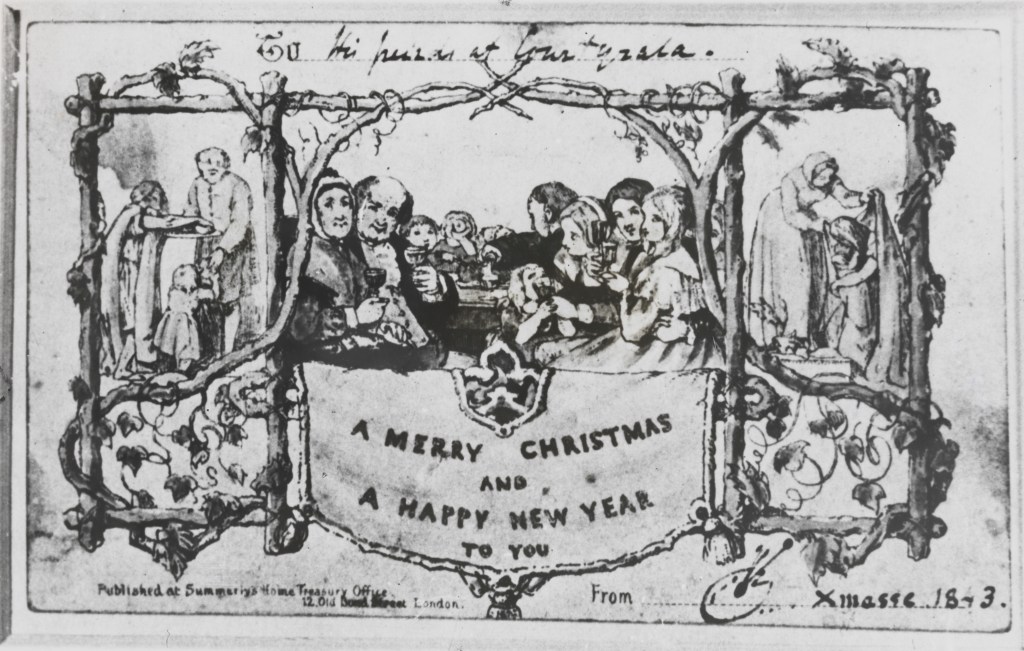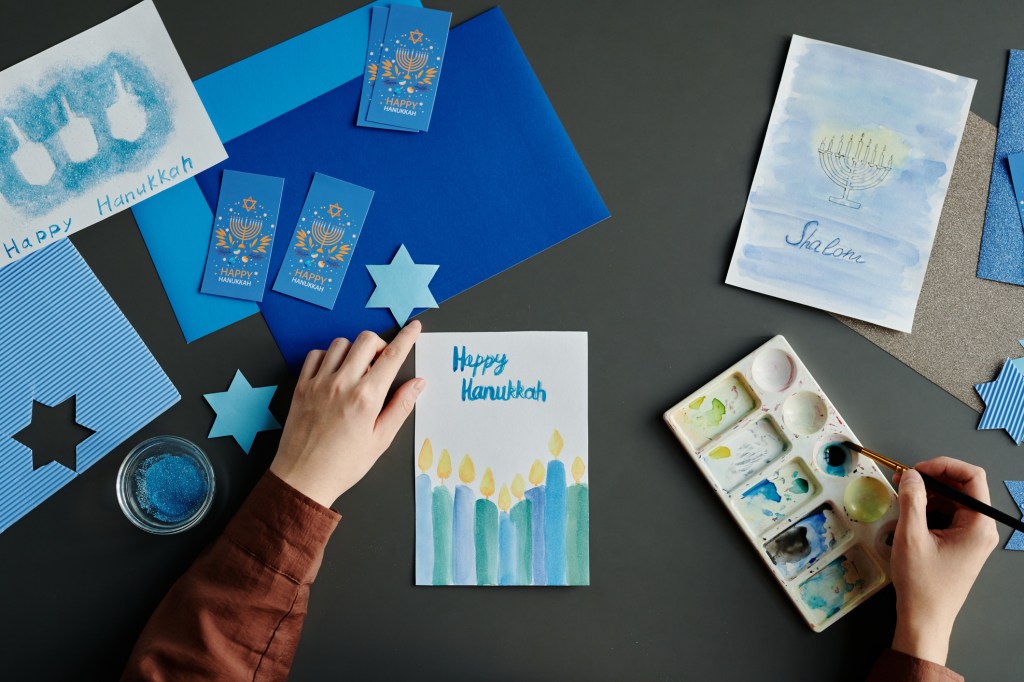Henry Cole was blessed with a bevy of friends and acquaintances in Victorian England’s upper echelon. But the respected civil servant, inventor, and educator had a problem — he was too popular. Cole is credited with sending the first annual holiday letter in 1843, a practice that soon became customary in the United Kingdom. It began when Cole, a busy man, was distressed at his ever-growing pile of unanswered mail during the holiday season. Not responding wasn’t an option, as that would appear rude, but writing dozens of individual replies would be an all too time-consuming task. Enter the first Christmas card.
Cole asked a friend to illustrate a festive scene, overlaid with the text “A Merry Christmas and a Happy New Year to You,” with space in the bottom corner for a signature. He then commissioned a printer to transfer the design onto cardstock and print 1,000 copies, some of which he sent himself, while others he sold commercially. Though the business venture ultimately flopped, the commercialization of Christmas was already underway, as the printing and publishing industries were quickly evolving. Over the next few decades, holiday cards became increasingly voguish and widespread, transitioning from a bourgeois trend to a commonplace tradition — something Cole’s role in reforming the Uniform Penny Post made even more accessible.
Of course, holiday cards today have evolved a great deal from those of yesteryear, encompassing a diverse array of designs and seasonal celebrations. Still, they remain an integral part of wintertime festivities, from Yuletide and Hanukkah to Kwanzaa and New Year’s.

Henry Cole’s original Christmas Card
“Holiday cards are important because, in a digital-first world, they have become a meaningful rite of inclusion. If you are single, retired, or even a dog parent, you benefit as much from sending and receiving holiday cards as someone in a family of seven,” Suzann Robins, a holistic communication and etiquette expert in Coos Bay, Oregon, told Nice News. “I know people who send out 40 cards and receive 25 responses, but those 25 returned cards feel overwhelmingly validating.”
Although it may not seem like much, there’s a level of investment and care involved in crafting and mailing a note that carries more weight than a quick “Happy Holidays” text, Robins continued. “The sending of a card is the gift of your time, [and] the receiving of a card is a reminder that you are not forgotten.”
Moreover, writing cards invites us to pause and think about the people who matter to us, said Christine Harrison, psychotherapist, founder, and clinical supervisor at Focus Forward Therapy Group in Ottawa, Canada: “That quiet moment of reflection and the care that goes into choosing words can ease stress and remind us that we’re part of something bigger than ourselves.”
Just as with gifts, when it comes to cards, it’s the thought that counts. That said, there are a few things to keep in mind to make the most of your seasonal greetings. Here, mental health and etiquette experts discuss their top do’s and don’ts.
Do
Make It Personal
Personalization is key to a meaningful card, said Nick Leighton, an Emmy Award-winning talk show host, journalist, and etiquette expert in New York City.
“Relaying a pre-printed message and just signing your name doesn’t quite have the same effect as including a heartfelt note,” he said, suggesting that senders “add at least a short note to the card.”

Chloe Bean, a somatic trauma therapist in Los Angeles, advised including a personal memory or other detail. “For example, you might say, ‘I remember when we went to the movies and laughed for hours,’ or ‘It’s amazing to see how much you’ve grown into your own person’ (if addressing a younger person you knew as a child),” she said. You could also include something you’re grateful for in the relationship, Bean added, such as “Thank you for always being there” or “You inspire me to never give up.”
Be Authentic
When it comes to tone, most cards don’t need to be formal or fancy — unless that’s your thing. Generally, an authentic card that shows your personality is a better choice.
“Are you silly? Send a funny card. Spiritual? Send something profound,” Robins suggested. “The card itself can set the tone before it’s even opened. Recipients can tell when a card looks like it genuinely came from you, and that is what makes it resonate.”
Likewise, Harrison recommended writing in your natural voice. “Warmth matters more than polish. Instead of ‘Wishing you serenity in this festive season,’ [you might write] ‘I hope you get a chance to rest and watch your favorite holiday movie this week.’”
Go the Postal Route
If your budget allows for it, skip the e-cards and opt for printed or handwritten greetings. Digital cards work for international friends and family, but tangible letters are far more personal, said Lisa Mirza Grotts, an etiquette expert in Sonoma, California. “A personal touch in an impersonal age is always welcome.”

Leighton agreed. “There’s something nice about receiving a physical card. When so much of our communication is ephemeral, something you can actually hold really stands out and has a big impact,” he said. “You can’t easily put a text message on display on your mantle!”
Double-Check Names and Addresses
No one likes having their name misspelled, and you don’t want your cards to get lost in the mail due to an incorrect address.
“Check your holiday greeting card list and make sure people haven’t moved,” said Diane Gottsman, etiquette expert and owner of The Protocol School of Texas in San Antonio. “Update with their current name [if it’s changed due to marriage or divorce], and add the spouse’s name and children when appropriate.”
If you’re unsure about someone’s address, just ask, Leighton said. “Your holiday cards don’t need to be a complete surprise.”
Also, don’t forget the return address. “Not including [one] prevents any chance of reciprocity,” Robins advised.
Don’t
Write a Novel
Lengthy newsletter-style cards may come across as egotistical, unless it’s a brief recap of recent events, Gottsman said. “Leave out the drawn-out details. You can reach out personally if there is news that is significant to the holiday card receiver.”
Nicole Anders, a clinical psychologist in Las Vegas, agreed, adding that a long opus doesn’t have the same effect as a few lines of true, intentional writing. “There is no need to write a Hallmark screenplay,” she said.
Brag
As Gottsman mentioned, holiday cards aren’t the place to brag. If you’ve had a fantastic year, it’s OK to say so — just make sure that you’re not coming off as self-centered or boastful.

“Avoid turning it into a personal highlight reel or promotional update,” said Alyssa Mairanz, owner and executive director at Empower Your Mind Therapy in New York City. “This isn’t the time for business pitches or listing your kids’ accomplishments.”
Procrastinate
According to the United States Postal Service, it usually takes about one to five business days for standard, domestic First-Class Mail to reach its destination. But delivery times can lag during the holidays, so it’s best to send Christmas cards sooner than later — ideally within the first two weeks of December — to ensure they arrive in time. “A late card risks feeling like an afterthought,” Robins said. “[Plan] your mailing with enough time to show that you are organized and have put real thought into it.”
Be Inconsiderate
It’s important to bear in mind that the holiday season isn’t cheery for everyone. When writing to someone who may be going through a tough time (perhaps due to health issues or a loss), keep it gentle and genuine, Harrison suggested.
“Acknowledge that this season might be hard. Something like ‘Thinking of you and keeping you close in my heart this holiday’ can mean a great deal,” she said. “Presence and kindness matter far more than perfect words.”
Additionally, Anders recommends avoiding phrases such as “Everything happens for a reason” or anything beginning with “At least,” as these may feel dismissive or insensitive.
Overthink It
Be careful not to let anxiety or writer’s block get in the way of spreading holiday cheer. “Don’t [worry about finding] the ‘right’ words,” Harrison said. “Sincerity is more important than perfect phrasing.”

Bean agreed. “You can say one to two sentences: a personal appreciation about the person, what they bring to your life, and what your hope is for them or your relationship. But don’t feel the need to run it by an editor or overthink every word.”
The Bottom Line
Holiday cards are for everyone, no matter who you are or what you celebrate. And though they might seem like a small gesture, they hold incredible power, reminding us that we’re seen, loved, and thought of, Mairanz said. “The act of sending one isn’t just good for the recipient — it’s good for you, too. It nurtures gratitude, strengthens bonds, and can lift your own spirits. In a world that often moves too fast, a card is a meaningful pause — a little moment of care that can have a lasting impact.”












